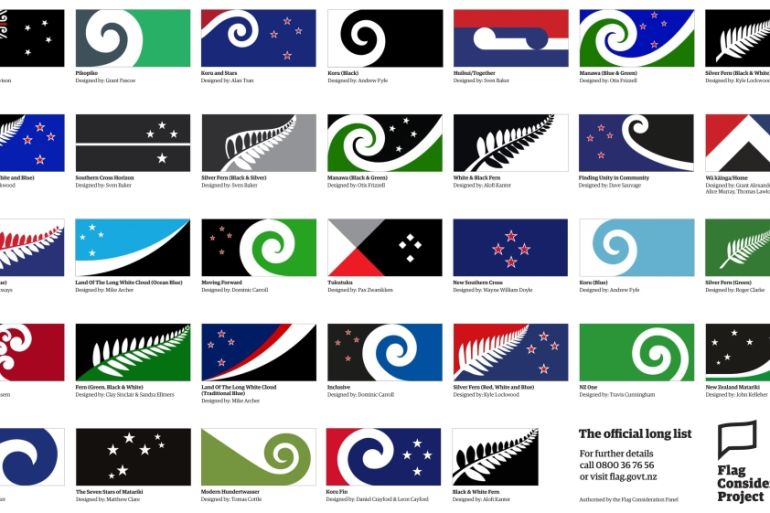New Zealand’s flag and precarious nationalism
Nationalism tends to be understated and reserved for several occasions in the public domain.

It’s been called a joke, a political stunt, and the cultural equivalent of a tea towel. The flag debate in New Zealand has hardly been the nation-building exercise the National Party-led government expected it to be.
However, despite its less than enthusiastic reception, there are signs that the country is willing to consider a new identity.
Keep reading
list of 4 itemsFocus on southern states as India votes in second phase of mammoth election
ByteDance prefers TikTok shutdown in US over sale: Report
Haiti Prime Minister Ariel Henry resigns, transitional council takes power
In March 2014, Prime Minister John Key announced that the national flag no longer represented New Zealand. Key reasoned that the current flag, with its Union Jack and four stars representing the Southern Cross, evoked an older version of the nation, one which was much more closely tied to their colonial yoke.
|
|
| Alternative Maori names for New Zealand islands |
The catch, of course, would be if Key’s National Party was elected in the following term. The very next day, Key announced the date for the 2014 general election.
Political stunt
The proximity of these two dates meant the move was largely read as a political stunt. The leader of the opposition, David Cunliffe, denounced the flag referendum as an attempt to drag the public’s attention away from bigger issues, such as the economy.
New Zealand’s system of proportional representation means that parties rarely gain more than three or four terms before switching to the other main centrist party, as voters fatigue of the incumbent.
Rolling into its third term and facing the aftermath of the global financial crisis and a major rebuild prompted by the Christchurch earthquake, Key faced no shortage of issues from which he might have wished to distract voters.
|
Dissent over the flag continues due to the way it is seen as lacking ‘authenticity’. The debate has centred on the lack of designers and vexillologists on the panel deciding the alternative flag, but it also exposes a deeper anxiety about what mainstream New Zealand culture is.
|
Others read the flag project as Key’s attempt to leave a personal mark on the country. Just a few months earlier, Key announced this was his “legacy project“, and that he had completed his own personal design of what he thought the flag should be.
The response from New Zealanders was brutal. Polls showed that as many as 70 percent of the country were opposed to change. The website that was created for people to submit designs was bombarded with mock submissions.
In these, New Zealand’s national flightless bird, the kiwi, shot lasers out of its eyes and spurted rainbows out its bottom. Children’s drawings were submitted as possible designs. Resistance to change was also exercised by refusing to attend the flag discussion sessions that were set up around the country.
In the absence of public support, opposition parties seized upon the cost of the exercise – at an extraordinarily conservative estimate of $27m – which they viewed as funding that could have gone to more important issues.
Key also faced dissent from within the ranks of his own party, when Tamaki MP Simon O’Connor uploaded a video of himself looking at all the flags while repeating the phrase “No”.
‘New’ nationalisms
Part of the reason politicians and artists have had such low success with the idea of flag change is the complicated relationship that New Zealanders have with nationalism.
Up until the 1970s, the dominant culture closely identified with Britain, seeing itself as an agricultural hub. From that decade onwards, the country began to develop its own distinct identity, with waves of Pacific and Asian migration changing the ethnic makeup to one that was much more multicultural.
As the historian Michael King argues, the prior emphasis on Britain had left the dominant white culture with the feeling that it didn’t have its own distinct identity.

Expressions of nationalism are often drawn from the indigenous Maori culture as a marker of uniqueness, but the aim is to assimilate rather than to explore the fissures that lie beneath the two cultures.
Nowhere is this complicated relationship with nationalism more evident than the national day, which commemorates the signing of the controversial Treaty of Waitangi that led to three decades of civil war – an annual event that never fails to highlight the uneasy relationship between the two cultures.
For this reason, nationalism tends to be understated and reserved for three occasions in the public domain: rugby, international sport, and the commemoration of the two World Wars.
King’s criticisms were often echoed by Maori writers during the 1980s and ’90s – New Zealand was a country that didn’t really know who it was.
Acquired nationalism
Dissent over the flag continues due to the way it is seen as lacking “authenticity”. The debate has centred on the lack of designers and vexillologists on the panel deciding on the alternative flag, but it also exposes a deeper anxiety about what mainstream New Zealand culture is.
Of the final four designs from which the public can choose, three are almost identical images of Key’s preferred insignia – the silver fern. It is also the symbol of commercial rugby culture, which forms the main engine of advertising and nationalism in the country.
However, if New Zealanders are an apathetic bunch, there are signs this week that the nationalism lying beneath the surface may yet come out kicking. An outlier flag called “Red Peak” has emerged from nowhere to gain 40,000 signatures in a petition.
Virtually identical to another flag that no one liked that was pushed by millionaire economist Gareth Morgan, this flag’s sudden popularity is due to a GIF image that explains its relevance to Maori culture.
So far Key has rejected calls to include it as part of the referendum, unless one of the opposition parties introduces a bill into the House to force its inclusion in the debate. This is a deft political move that will be used to further stimulate public interest and to justify the initial debate until the fifth flag is eventually assimilated into the 2017 referendum choices.
Phoebe Fletcher is a New Zealand political commentator who has taught at Massey and the University of Auckland. Her PhD was on American images of the Global War on Terror.
The views expressed in this article are the author’s own and do not necessarily reflect Al Jazeera’s editorial policy.
